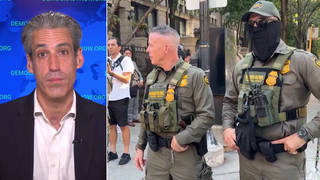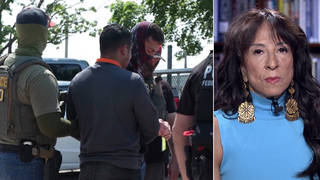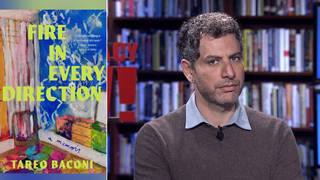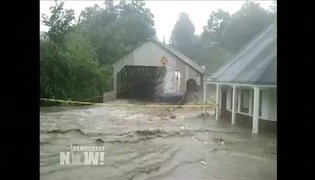
A growing tropical depression that could drop 15 inches of rain on the Gulf Coast this weekend comes just a week after Hurricane Irene devastated parts of the East Coast. We look at one of the hardest-hit areas: the Catskills region of New York. While flood waters have largely receded, the cleanup and rebuilding effort has just begun and will take months. At least 600 homes and 140,000 acres of farmland have been destroyed. State officials estimate 150 major highways need to be partially rebuilt, and 22 state bridges have been closed, leaving some sections of the Catskills completely cut off. New York Gov. Andrew Cuomo says that the state faces $1 billion in damages from the powerful tropical storm. We speak with Lissa Harris, an editor of the Watershed Post, a website based in the Catskills that has become one of the region’s main sources of news on the disaster. [includes rush transcript]
Transcript
JUAN GONZALEZ: The state of Louisiana has declared a state of emergency ahead of a growing tropical depression that could drop 15 inches of rain on the region this weekend. Exxon Mobil, BP and Shell have all shut down their offshore oil platforms. The storm comes just a week after Hurricane and Tropical Storm Irene devastated parts of the East Coast.
We turn now to look at one of the hardest-hit areas: the Catskills regions of New York. While flood waters have largely receded, the cleanup and rebuilding effort has just begun and will take months. At least 600 homes and 140,000 acres of farmland have been destroyed. State officials estimate 150 major highways need to be partially rebuilt. Twenty-two state bridges have been closed, leaving some sections of the Catskills completely cut off.
AMY GOODMAN: The town of Prattsville was nearly wiped off the map. In nearby Margaretville, the flood waters washed away the town’s only grocery store. New York Governor Andrew Cuomo says the state faces a billion dollars in damages from the storm.
We’re going now to Lissa Harris, editor of the Watershed Post. It’s a new website based in the Catskills. It’s become one of the region’s main sources of news on the disaster. She’s joining us by Democracy Now! video stream from Delhi, New York.
Lissa, describe what has happened in your communities and what you’re doing about it at Watershed Post.
LISSA HARRIS: Hi, Amy. Just a quick thing. We’re actually—we’re at our house in Andes, New York, which was spared by the floods, which is a good thing, or we wouldn’t be able to be publishing at this juncture. But yes, we have become sort of a lifeline for people through our real-time coverage in a time when official communications are extremely fast-changing and, in fact, difficult to get at all. It’s a very large area. The territory that we’re looking at is—that we cover, is about five counties, and it’s about 5,000 square miles. It’s almost the size of Connecticut. So, you can have an idea of the sort of challenges that we’re having getting information across the whole region.
AMY GOODMAN: Talk about what’s happened there.
LISSA HARRIS: Well, we—like you said, there have been many communities that have been hit extremely hard by flooding and practically obliterated in some places. Prattsville—Governor Cuomo has visited Prattsville, and it is a complete disaster. There are other places. Windham, Tannersville have been very hard-hit. Like you said, Margaretville, most of the downtown was extremely hard-hit. Our grocery store and our CVS was lost. And Fleischmanns has National Guard at the moment. It’s a very—sorry, I think we’re still getting word out from places like some of the most hard-hit places in Greene County and also in the Schoharie Valley, where it’s been tough to get information, but we know that there is so much devastation happening there. And there’s a lot of towns that have been hard-hit, and then others that are really—have been spared. So, it’s a patchwork.
JUAN GONZALEZ: And Lissa, why was that area, so far inland, so hard-hit?
LISSA HARRIS: Well, we just got a ton of rain. And the Catskills, it’s a place that’s full of water. We are the water supply for New York City, and it’s just a patchwork crisscrossed with many, many streams, from little tiny creeks to larger waterways. And every time we get a lot of rain, all those creeks swell, and they flood the towns in the valley. And we’ve just gotten—
AMY GOODMAN: Lissa, we only have a few seconds. Can you talk about the Watershed Post and what you’re doing, how this daily blog works?
LISSA HARRIS: We are two people at Watershed Post headquarters. But in the last week, our ranks have swelled considerably. The community is pitching in to get us real-time information, and we are pushing it out as fast as we can via a live blog at the top of watershedpost.com. We are also on Twitter.
FEMA is in touch with us. I got a phone call from them yesterday. They promised to put me in touch with their social media specialist. We are combing Twitter and Facebook and email and our own contacts and everything that we can think of to try and get and verify information about what’s happening. We have pro reporters volunteering for us. We are collaborating with other newspapers, with radio stations. It’s incredible.
AMY GOODMAN: Lissa Harris, we want to thank you for being with us, editor at Watershed Post. People are using it to find loved ones, announce people’s location to family members, warning what roads are out, what communities are gone. You can link to it, as well. We will at democracynow.org.











Media Options